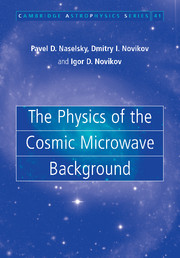Book contents
- Frontmatter
- Contents
- Preface to the Russian edition
- Preface to the English edition
- 1 Observational foundations of modern cosmology
- 2 Kinetics of electromagnetic radiation in a uniform Universe
- 3 The ionization history of the Universe
- 4 Primordial CMB and small perturbations of uniform cosmological model
- 5 Primary anisotropy of the cosmic microwave background
- 6 Primordial polarization of the cosmic microwave background
- 7 Statistical properties of random fields of anisotropy and polarization in the CMB
- 8 The Wilkinson Microwave Anisotropy Probe (WMAP)
- 9 The ‘Planckian era’ in the study of anisotropy and polarization of the CMB
- 10 Conclusion
- References
- Index
9 - The ‘Planckian era’ in the study of anisotropy and polarization of the CMB
Published online by Cambridge University Press: 18 August 2009
- Frontmatter
- Contents
- Preface to the Russian edition
- Preface to the English edition
- 1 Observational foundations of modern cosmology
- 2 Kinetics of electromagnetic radiation in a uniform Universe
- 3 The ionization history of the Universe
- 4 Primordial CMB and small perturbations of uniform cosmological model
- 5 Primary anisotropy of the cosmic microwave background
- 6 Primordial polarization of the cosmic microwave background
- 7 Statistical properties of random fields of anisotropy and polarization in the CMB
- 8 The Wilkinson Microwave Anisotropy Probe (WMAP)
- 9 The ‘Planckian era’ in the study of anisotropy and polarization of the CMB
- 10 Conclusion
- References
- Index
Summary
Introduction
The completion of the recent balloon experiments BOOMERANG, MAXIMA-1, TOP-HAT and ground-based experiments DASI, CBI and VSA ushered in a new phase in the experimental investigation of anisotropy and polarization of the cosmic microwave background. The satellite WMAP, launched successfully in June 2001, opened a new era in the study of the CMB anisotropy and polarization, which differs from previous experiments in its greater accuracy of finding the characteristics of the cosmological signal, and hence of the cosmological parameters. We mean here the Hubble constant H0, the density Ωb of the baryonic fraction of matter in the Universe, the hidden mass density Ωdm, the dark energy density ΩΛ (the vacuum?), the exponent n in the spectrum of adiabatic perturbations, and a number of others.
An international satellite, PLANCK, whose aim is to measure anisotropy and polarization of the primordial radiation with unprecedented accuracy is scheduled for launch in 2007. The accepted opinion is that PLANCK will summarize more than 35 years of progress in the theoretical and experimental study of polarization and anisotropy of the CMB and will allow us to come very close to building a realistic model of the Universe.
Before discussing the main features contributed by WMAP and PLANCK, we briefly sum up the results achieved by radioastronomy and cosmology in studying the CMB anisotropy.
- Type
- Chapter
- Information
- The Physics of the Cosmic Microwave Background , pp. 225 - 239Publisher: Cambridge University PressPrint publication year: 2006

